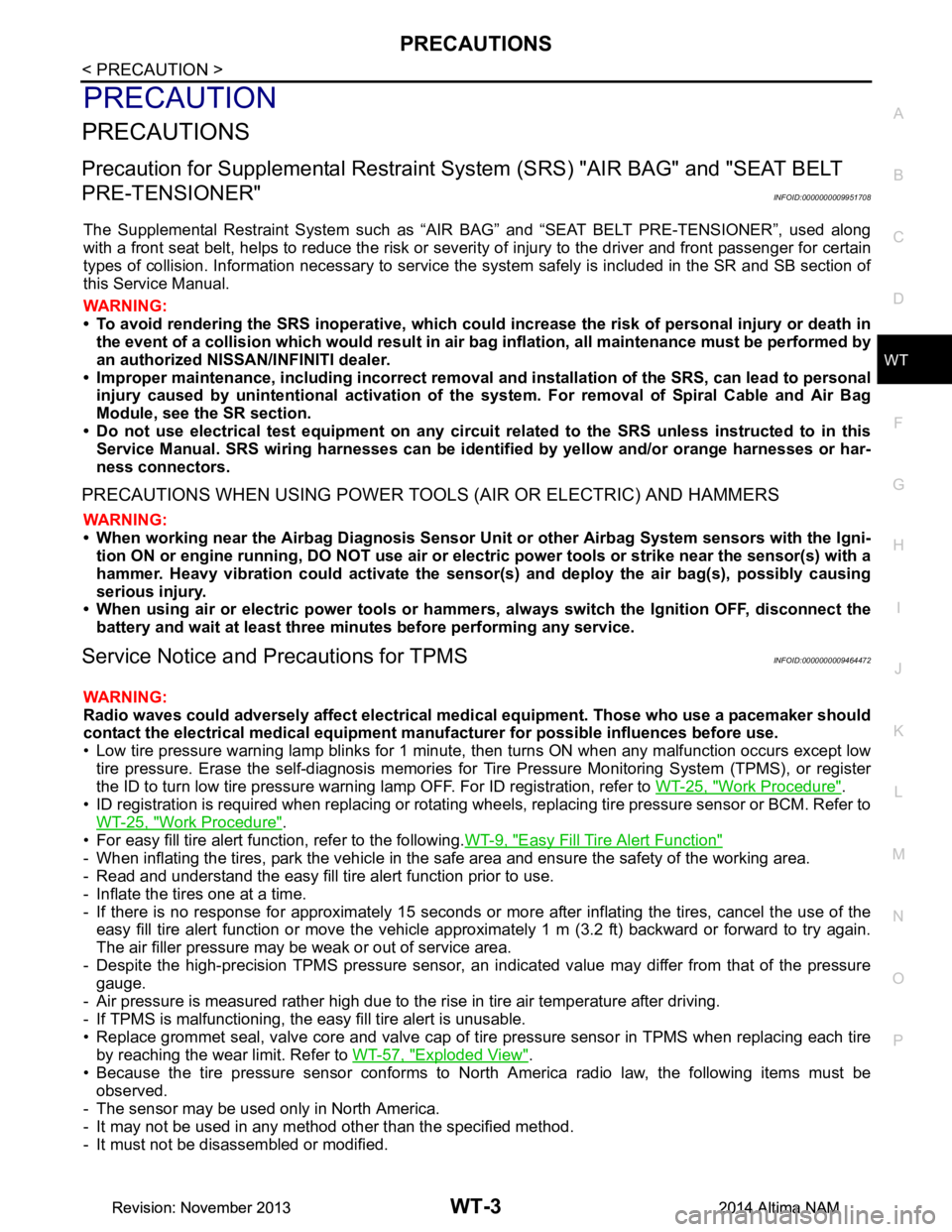2014 NISSAN TEANA wheel
[x] Cancel search: wheelPage 4476 of 4801
![NISSAN TEANA 2014 Service Manual
TCM
TM-261
< ECU DIAGNOSIS INFORMATION > [CVT: RE0F10E]
C
EF
G H
I
J
K L
M A
B
TM
N
O P
Protection Control INFOID:0000000009464220
The TCM becomes the protection control status temporar ily to prote NISSAN TEANA 2014 Service Manual
TCM
TM-261
< ECU DIAGNOSIS INFORMATION > [CVT: RE0F10E]
C
EF
G H
I
J
K L
M A
B
TM
N
O P
Protection Control INFOID:0000000009464220
The TCM becomes the protection control status temporar ily to prote](/manual-img/5/57390/w960_57390-4475.png)
TCM
TM-261
< ECU DIAGNOSIS INFORMATION > [CVT: RE0F10E]
C
EF
G H
I
J
K L
M A
B
TM
N
O P
Protection Control INFOID:0000000009464220
The TCM becomes the protection control status temporar ily to protect the safety when the safety of TCM and
transmission is lost. It automatically returns to the normal status if the safety is secured.
The TCM has the following protection control.
CONTROL FOR WHEEL SPIN
TORQUE IS REDUCED WHEN DRIVING WITH THE REVERSE GEAR
CONTROL WHEN FLUID TEMPERATURE IS HIGH
P2765 •Start is slow
• Acceleration is slow
• Lock-up is not performed —
P2813 • Selector shock is large
•Start is slow
• Acceleration is slow
• Vehicle speed is not increased When a malfunction occurs on the low oil pressure side
• Selector shock is large When a malfunction occurs on the high oil pressure side
P2814 • Selector shock is large —
P2815 • Selector shock is large —
U0073 • Selector shock is large
•Start is slow
• Acceleration is slow
• Lock-up is not performed —
U0100 • Selector shock is large
•Start is slow
• Acceleration is slow
• Lock-up is not performed —
U0140 • Not changed from normal driving —
U0141 • Not changed from normal driving —
U0155 • Not changed from normal driving —
U0300 • Selector shock is large
•Start is slow
• Acceleration is slow
• Lock-up is not performed —
U1000 • Not changed from normal driving — U1117 • Not changed from normal driving — DTC Vehicle behavior Conditions of vehicle
Control
When a wheel spin is detected, the engine output and gear ratio are limited and the line pressure is increased.
Limits engine output when a wheel spin occurs in any of right and left drive wheels.
Vehicle behavior in
control If the accelerator is kept depressing during wheel spin, the engine revolution and vehicle speed are limited to
a certain degree.
Normal return condi-
tion Wheel spin convergence returns the control to the normal control.
Control Engine output is controlled according to a vehicle speed while reversing the vehicle.
Vehicle behavior in
control Power performance may be lowered while reversing the vehicle.
Normal return condi-
tion Torque returns to normal by positioning the sele
ctor lever in a range other than “R” position.
Revision: November 20132014 Altima NAMRevision: November 20132014 Altima NAM
Page 4504 of 4801
![NISSAN TEANA 2014 Service Manual
CVT POSITIONTM-289
< BASIC INSPECTION > [CVT: RE0F10E]
C
EF
G H
I
J
K L
M A
B
TM
N
O P
CVT POSITION
InspectionINFOID:0000000009464234
1. Turn ON the ignition switch with the shift selector at the � NISSAN TEANA 2014 Service Manual
CVT POSITIONTM-289
< BASIC INSPECTION > [CVT: RE0F10E]
C
EF
G H
I
J
K L
M A
B
TM
N
O P
CVT POSITION
InspectionINFOID:0000000009464234
1. Turn ON the ignition switch with the shift selector at the �](/manual-img/5/57390/w960_57390-4503.png)
CVT POSITIONTM-289
< BASIC INSPECTION > [CVT: RE0F10E]
C
EF
G H
I
J
K L
M A
B
TM
N
O P
CVT POSITION
InspectionINFOID:0000000009464234
1. Turn ON the ignition switch with the shift selector at the “P” position.
2. Press the shift selector button with the brake pedal depressed, and confirm that the shift selector can be
moved to positions other than “P”. Also confirm that movement is not allowed from the “P” position to other
position without depressing the brake pedal.
3. Move the shift selector and check for “excessive effort”, “sticking”, “noise” or “rattle”.
4. Confirm that shift selector stops at each position with the feel of engagement when it is moved through all
the positions. Check whether or not the actual position the shift selector is in matches the position shown
by the transaxle body.
5. Make sure that the shift selector is moved to all the shift posi- tions in the manner shown.
• (A): Press shift selector button to operate shift selector, while depressing the brake pedal.
• (B): Press shift selector button to operate shift selector.
• (C): Shift selector can be operated without pressing the shift selector button.
6. When the shift selector button is pressed without applying for- ward/backward force to the shift selector at “P”, “R”, “N”, “D” or
“Ds” positions, there should be no “sticking” on the shift selector
button operation.
7. Check that the back-up lamps do not illuminate when the shift selector is in the “P” position.
8. Check that the engine can be started with the sh ift selector in the “P” and “N” positions only.
9. Check that the transaxle is locked completely when the shift selector is in the “P” position.
AdjustmentINFOID:0000000009464235
1. Shift the shift selector to the “P” position.
CAUTION:
Turn wheels at least a quarter turn and be certain the park position mechanism is fully engaged.
2. Loosen the control cable nut. CAUTION:
Do not apply force to the manual lever.
3. Position the manual lever in the “P” position.
4. Tighten the control cable nut to specified torque. Refer to TM-
380, "Exploded View".
CAUTION:
Hold manual lever when tightening.
AWDIA1019ZZ
JSDIA1875ZZ
Revision: November 20132014 Altima NAMRevision: November 20132014 Altima NAM
Page 4597 of 4801
![NISSAN TEANA 2014 Service Manual
TM-382
< REMOVAL AND INSTALLATION >[CVT: RE0F10E]
PADDLE SHIFTER
PADDLE SHIFTER
Exploded ViewINFOID:0000000009464338
Removal and InstallationINFOID:0000000009464339
REMOVAL
1. Park the vehicle on a l NISSAN TEANA 2014 Service Manual
TM-382
< REMOVAL AND INSTALLATION >[CVT: RE0F10E]
PADDLE SHIFTER
PADDLE SHIFTER
Exploded ViewINFOID:0000000009464338
Removal and InstallationINFOID:0000000009464339
REMOVAL
1. Park the vehicle on a l](/manual-img/5/57390/w960_57390-4596.png)
TM-382
< REMOVAL AND INSTALLATION >[CVT: RE0F10E]
PADDLE SHIFTER
PADDLE SHIFTER
Exploded ViewINFOID:0000000009464338
Removal and InstallationINFOID:0000000009464339
REMOVAL
1. Park the vehicle on a level surface.
2. Remove the driver air bag module. Refer to SR-11, "Removal and Installation"
.
3. Remove the steering wheel. Refer to ST-31, "Removal and Installation"
.
4. Remove the column cover. Refer to IP-17, "Removal and Installation"
.
1. Steering column assembly 2. Paddle shifter (shift-down) 3. Paddle shifter (shift-up)
AWDIA0557GB
Revision: November 20132014 Altima NAMRevision: November 20132014 Altima NAM
Page 4676 of 4801

WT-1
SUSPENSION
C
D
F
G H
I
J
K L
M
SECTION WT
A
B
WT
N
O PCONTENTS
ROAD WHEELS & TIRES
PRECAUTION ................ ...............................3
PRECAUTIONS .............................................. .....3
Precaution for Supplemental Restraint System
(SRS) "AIR BAG" and "SEAT BELT PRE-TEN-
SIONER" ............................................................. ......
3
Service Notice and Precautions for TPMS ................3
Precaution for Road Wheel .......................................4
PREPARATION ............................................5
PREPARATION .............................................. .....5
Special Service Tool ........................................... ......5
Commercial Service Tool ..........................................5
SYSTEM DESCRIPTION ..............................6
COMPONENT PARTS ................................... .....6
Component Parts Location .................................. ......6
Component Description .............................................6
BCM ..........................................................................6
Transmitter ................................................................7
Remote Keyless Entry Receiver ...............................7
Outside Key Antennas ..............................................7
Combination Meter ....................................................7
SYSTEM ..............................................................8
System Diagram .................................................. ......8
System Description ...................................................9
Easy Fill Tire Alert Function ......................................9
DIAGNOSIS SYSTEM (BCM) ............................10
COMMON ITEM ..................................................... ....10
COMMON ITEM : CONSULT Function (BCM -
COMMON ITEM) ................................................. ....
10
AIR PRESSURE MONITOR ......................................11
AIR PRESSURE MONITOR : CONSULT Function
(BCM-AIR PRESSURE MO NITOR) ........................
11
ECU DIAGNOSIS INFORMATION ........... ...13
BCM ...................................................................13
List of ECU Reference ......................................... ....13
WIRING DIAGRAM ......................................14
TIRE PRESSURE MONITORING SYSTEM ......14
Wiring Diagram - With Individual Tire Pressure
Display ................................................................. ....
14
Wiring Diagram - Without Individual Tire Pressure
Display ................................................................. ....
20
BASIC INSPECTION ...................................24
DIAGNOSIS AND REPAIR WORK FLOW .......24
Work Flow ............................................................ ....24
ID REGISTRATION PROCEDURE ...................25
Description ...............................................................25
Work Procedure .......................................................25
DTC/CIRCUIT DIAGNOSIS .........................28
C1704, C1705, C1706, C1707 LOW TIRE
PRESSURE .......................................................
28
DTC Logic ............................................................ ....28
Diagnosis Procedure ...............................................28
C1708, C1709, C1710, C1711 TRANSMITTER
(NO DATA) ........................................................
30
DTC Logic ............................................................ ....30
Diagnosis Procedure ...............................................30
C1712, C1713, C1714, C1715 TRANSMITTER
(CHECKSUM) ....................................................
33
DTC Logic ............................................................ ....33
Diagnosis Procedure ...............................................33
C1716, C1717, C1718, C1719 TRANSMITTER
(PRESSURE DATA) ..........................................
35
DTC Logic ............................................................ ....35
Diagnosis Procedure ...............................................35
Revision: November 20132014 Altima NAMRevision: November 20132014 Altima NAM
Page 4677 of 4801

WT-2
C1720, C1721, C1722, C1723 TRANSMITTER ...
37
DTC Logic ............................................................ ...37
Diagnosis Procedure ..............................................37
C1724, C1725, C1726, C1727 TRANSMITTER
(BATT VOLT) .................................................. ...
39
DTC Logic ............................................................ ...39
Diagnosis Procedure ..............................................39
C1729 VEHICLE SPEED SIGNAL ....................41
DTC Logic ............................................................ ...41
Diagnosis Procedure ..............................................41
C1730, C1731, C1732, C1733 FLAT TIRE ........42
DTC Logic ............................................................ ...42
Diagnosis Procedure ..............................................42
C1734 BCM ........................................................44
DTC Logic ............................................................ ...44
Diagnosis Procedure ..............................................44
C1735 IGNITION SIGNAL .................................46
DTC Logic ............................................................ ...46
Diagnosis Procedure ..............................................46
SYMPTOM DIAGNOSIS .............................48
TPMS .............................................................. ...48
Symptom Table ................................................... ...48
LOW TIRE PRESSURE WARNING LAMP
DOES NOT TURN ON .................................... ...
49
Low Tire Pressure Warning Lamp Does Not Come
On When Ignition Switch Is Turned On ............... ...
49
LOW TIRE PRESSURE WARNING LAMP
STAYS ON ...................................................... ...
50
Low Tire Pressure Warning Lamp Stays On When
Ignition Switch Is Turned On ................................ ...
50
EASY FILL TIRE ALERT DOES NOT ACTI-
VATE ............................................................... ...
51
Description ........................................................... ...51
Diagnosis Procedure ...............................................51
NOISE, VIBRATION AND HARSHNESS
(NVH) TROUBLESHOOTING ......................... ...
52
NVH Troubleshooting Chart ....................................52
PERIODIC MAINTENANCE .......................53
ROAD WHEEL ................................................ ...53
Inspection ............................................................. ...53
REMOVAL AND INSTALLATION ..............54
REMOTE KEYLESS ENTRY RECEIVER ...... ...54
Removal and Installation .........................................54
ROAD WHEEL TIRE ASSEMBLY ................. ...55
Adjustment ........................................................... ...55
UNIT REMOVAL AND INSTALLATION ....57
TIRE PRESSURE SENSOR ........................... ...57
Exploded View ..................................................... ...57
Removal and Installation .........................................57
SERVICE DATA AND SPECIFICATIONS
(SDS) ............... ...........................................
60
SERVICE DATA AND SPECIFICATIONS
(SDS) .............................................................. ...
60
Road Wheel ......................................................... ...60
Tire ..........................................................................60
Revision: November 20132014 Altima NAMRevision: November 20132014 Altima NAM
Page 4678 of 4801

PRECAUTIONSWT-3
< PRECAUTION >
C
D
F
G H
I
J
K L
M A
B
WT
N
O P
PRECAUTION
PRECAUTIONS
Precaution for Supplemental Restraint System (SRS) "AIR BAG" and "SEAT BELT
PRE-TENSIONER"
INFOID:0000000009951708
The Supplemental Restraint System such as “A IR BAG” and “SEAT BELT PRE-TENSIONER”, used along
with a front seat belt, helps to reduce the risk or severi ty of injury to the driver and front passenger for certain
types of collision. Information necessary to service t he system safely is included in the SR and SB section of
this Service Manual.
WARNING:
• To avoid rendering the SRS inoper ative, which could increase the risk of personal injury or death in
the event of a collision which would result in air bag inflation, all maintenance must be performed by
an authorized NISSAN/INFINITI dealer.
• Improper maintenance, including in correct removal and installation of the SRS, can lead to personal
injury caused by unintentional act ivation of the system. For removal of Spiral Cable and Air Bag
Module, see the SR section.
• Do not use electrical test equipm ent on any circuit related to the SRS unless instructed to in this
Service Manual. SRS wiring harnesses can be identi fied by yellow and/or orange harnesses or har-
ness connectors.
PRECAUTIONS WHEN USING POWER TOOLS (AIR OR ELECTRIC) AND HAMMERS
WARNING:
• When working near the Airbag Diagnosis Sensor Un it or other Airbag System sensors with the Igni-
tion ON or engine running, DO NOT use air or el ectric power tools or strike near the sensor(s) with a
hammer. Heavy vibration could activate the sensor( s) and deploy the air bag(s), possibly causing
serious injury.
• When using air or electric power tools or hammers , always switch the Ignition OFF, disconnect the
battery and wait at least three mi nutes before performing any service.
Service Notice and Precautions for TPMSINFOID:0000000009464472
WARNING:
Radio waves could adversely affect electrical medi cal equipment. Those who use a pacemaker should
contact the electrical medical equipment manu facturer for possible influences before use.
• Low tire pressure warning lamp blinks for 1 minute, then turns ON when any malfunction occurs except low
tire pressure. Erase the self-diagnosis memories for Tire Pressure Monitoring System (TPMS), or register
the ID to turn low tire pressure warning lamp OFF. For ID registration, refer to WT-25, "Work Procedure"
.
• ID registration is required when replacing or rotating wheels, replacing tire pressure sensor or BCM. Refer to WT-25, "Work Procedure"
.
• For easy fill tire alert function, refer to the following. WT-9, "Easy Fill Tire Alert Function"
- When inflating the tires, park the vehicle in the safe area and ensure the safety of the working area.
- Read and understand the easy fill tire alert function prior to use.
- Inflate the tires one at a time.
- If there is no response for approximately 15 seconds or mo re after inflating the tires, cancel the use of the
easy fill tire alert function or move the vehicle approximately 1 m (3.2 ft) backward or forward to try again.
The air filler pressure may be weak or out of service area.
- Despite the high-precision TPMS pressure sensor, an i ndicated value may differ from that of the pressure
gauge.
- Air pressure is measured rather high due to the rise in tire air temperature after driving.
- If TPMS is malfunctioning, the easy fill tire alert is unusable.
• Replace grommet seal, valve core and valve cap of tire pressure sensor in TPMS when replacing each tire
by reaching the wear limit. Refer to WT-57, "Exploded View"
.
• Because the tire pressure sensor conforms to No rth America radio law, the following items must be
observed.
- The sensor may be used only in North America.
- It may not be used in any method other than the specified method.
- It must not be disassembled or modified.
Revision: November 20132014 Altima NAMRevision: November 20132014 Altima NAM
Page 4679 of 4801

WT-4
< PRECAUTION >
PRECAUTIONS
Precaution for Road Wheel
INFOID:0000000009464473
• Genuine NISSAN aluminum wheel is designed for each type of vehicle. Use it on the specified vehicle only.
• Use Genuine NISSAN parts for the wheel nuts.
• Always adjusting the wheel balance prior to using them . For the balance weights, use Genuine NISSAN alu-
minum wheel weights.
• Use caution when handling the aluminum wheels, because they can be easily scratched. When removing
dirt, do not use any abrasives, a wire brush, or other it ems that may scratch the coating. Use a neutral deter-
gent if a detergent is needed.
• After driving on roads scattered with anti-ici ng salts, wash off the wheels completely.
• When installing road wheels onto the vehicle, always wipe of f any dirt or foreign substances to prevent them
from being trapped between the contact surfaces of wheel.
• Do not apply oil to nut and bolt threads.
Revision: November 20132014 Altima NAMRevision: November 20132014 Altima NAM
Page 4682 of 4801

COMPONENT PARTSWT-7
< SYSTEM DESCRIPTION >
C
D
F
G H
I
J
K L
M A
B
WT
N
O P
TransmitterINFOID:0000000009464479
A sensor-transmitter integrated with a valve is instal led in each wheel, and transmits a detected air pressure
signal in the form of a radio wave. The radio signal is received by the remote keyless entry receiver.
Remote Keyless Entry ReceiverINFOID:0000000009464480
The remote keyless entry receiver receives the air pressure signal transmitted by the transmitter in each
wheel.
Outside Key AntennasINFOID:0000000009464481
For vehicles equipped with individual tire pressure display in the combination meter, the outside key antennas
(driver side, passenger side and rear bumper) are used by the BCM to identify the location of the transmitters.
Combination MeterINFOID:0000000009464482
The combination meter receives tire pressure status from the BCM via CAN communication. The combination
meter will display the low tire pressure warning lamp when a low tire pressure or system malfunction is
detected by the BCM. A warning message will also be displayed in the vehicle information display. Refer to the
Owner’s Manual for additional information.
Revision: November 20132014 Altima NAMRevision: November 20132014 Altima NAM